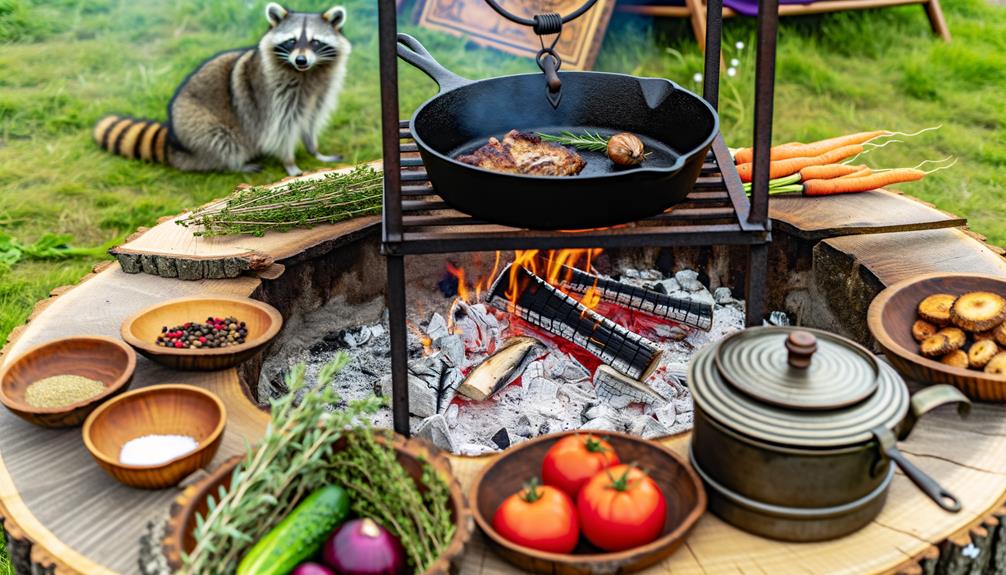How You Can Safely Eat Raccoon Meat Year-Round
Consuming raccoon meat year-round requires adherence to local regulations regarding hunting and trapping permits. Many regions set specific hunting seasons based on population studies, typically aligning with non-breeding periods to guarantee ecological balance.
Health standards are critical due to the potential for zoonotic diseases; proper handling and thorough cooking are necessary. Raccoon meat offers nutritional benefits, including high-quality protein and essential vitamins.
Ethical and environmental considerations also play a role in sustainable consumption and habitat conservation. For an in-depth understanding of raccoon consumption practices, including legalities, health effects, and cultural significance, detailed information is available.

Key Takeaways
- Legal regulations vary, and some regions may require permits or have restrictions on year-round raccoon consumption.
- Seasonal hunting regulations are designed to ensure ecological sustainability and prevent overharvesting.
- Proper handling and cooking are essential to avoid zoonotic disease risks when consuming raccoon meat year-round.
- Ethical considerations and cultural significance influence the sustainable and humane consumption of raccoon meat.
- Continuous monitoring and population management strategies are crucial to prevent ecological imbalances from year-round hunting.
Legal Considerations

Before considering raccoon as a year-round food source, it is important to understand the legal regulations that govern the hunting, trapping, and consumption of raccoons in different jurisdictions. Legal statutes vary significantly across regions, with some areas imposing strict limitations on raccoon hunting to protect local ecosystems and biodiversity.
For instance, certain states may require specific permits or licenses for trapping raccoons, while others might designate raccoons as nuisance animals that can be taken without a permit. Data from wildlife management agencies indicate that compliance with these regulations guarantees sustainable population levels and minimizes potential legal repercussions.
Additionally, understanding local health and safety standards for processing and consuming raccoon meat is vital to ensure it is safe for human consumption.
Seasonal Hunting Regulations
Seasonal hunting regulations for raccoons are designed to balance ecological sustainability with hunting opportunities by setting specific timeframes during which raccoon hunting is permitted. These regulations are typically determined by state wildlife agencies based on population studies and environmental impact assessments.
For example, most states in the U.S. designate raccoon hunting seasons that align with periods when raccoons are neither breeding nor rearing young. This approach helps maintain stable raccoon populations while allowing for sustainable hunting practices.
Additionally, hunting seasons often vary by region, reflecting local ecological conditions and raccoon population dynamics. By adhering to these regulated periods, hunters contribute to the conservation of raccoon populations and the broader ecosystem, ensuring that hunting remains a viable activity.
Health and Safety

Promoting health and safety in the context of raccoon hunting and consumption involves understanding zoonotic disease risks and proper handling procedures. Raccoons can carry diseases such as rabies, leptospirosis, and Baylisascaris procyonis (raccoon roundworm). Proper precautions include wearing gloves during handling and thoroughly cooking the meat to an internal temperature of at least 160°F (71°C) to eliminate pathogens.
Additionally, field dressing should be performed with sterilized tools to avoid cross-contamination. Freezing the meat for an extended period before consumption can also help in reducing parasitic risks. Adhering to these measures promotes that raccoon meat is safe for consumption and minimizes potential health hazards.
Understanding the biological risks and maintaining strict hygiene protocols is essential for safe consumption.
Nutritional Benefits
Raccoon meat offers a notable protein content, which is essential for muscle repair and overall health.
Additionally, it provides a range of essential vitamins such as B12 and niacin, contributing to energy metabolism and neurological function.
This subtopic will explore the specific nutritional benefits associated with consuming raccoon meat year-round.
Protein Content Analysis
Analyzing the protein content of raccoon meat reveals significant nutritional benefits that could support dietary needs year-round. Raccoon meat is a viable source of high-quality protein, essential for muscle repair and growth. A 100-gram serving of raccoon meat typically provides approximately 28 grams of protein. This protein content is comparable to that of more commonly consumed meats, such as chicken and beef. The table below outlines the protein content in raccoon meat compared to other meats:
| Meat Type | Protein Content (per 100g) |
|---|---|
| Raccoon | 28g |
| Chicken | 31g |
| Beef | 26g |
| Pork | 25g |
This data-driven comparison highlights raccoon meat's potential as a protein-rich component in a balanced diet.
Essential Vitamins Breakdown
In addition to its high protein content, raccoon meat is also rich in essential vitamins that contribute greatly to overall health and well-being.
Raccoon meat is a notable source of B vitamins, particularly B12 and niacin (B3), which are essential for energy metabolism and maintaining neurological function.
Moreover, it contains significant levels of vitamin A, important for vision, immune function, and cellular communication.
Raccoon meat also provides moderate amounts of vitamin E, an antioxidant that plays a role in protecting cells from oxidative stress.
These vitamins collectively enhance metabolic processes, support immune response, and promote cellular health, making raccoon meat not only a high-protein food source but also a nutritionally beneficial option year-round.
Ethical Concerns

Evaluating the ethical concerns of consuming raccoon meat requires a multifaceted examination of animal welfare, environmental impact, and cultural practices.
- Animal Welfare: Guaranteeing humane treatment during capture and slaughter is paramount. Studies indicate that stress and suffering can greatly affect the quality of meat and overall ethical considerations.
- Environmental Impact: Harvesting raccoons must be evaluated for sustainability. Overhunting can disrupt local ecosystems and biodiversity. Data-driven assessments are crucial to avoid long-term ecological damage.
- Cultural Practices: Raccoon consumption varies globally; understanding these practices can offer insights into ethical considerations. In some regions, raccoons are integral to local diets and traditions, which must be respected while evaluating ethical standards.
This thorough approach ensures an informed stance on the ethical consumption of raccoon meat.
Preparing Raccoon Meat
Proper preparation of raccoon meat necessitates meticulous cleaning, marinating, and cooking techniques to guarantee safety and palatability. Initial cleaning involves removing the fur, glands, and internal organs, as these parts can harbor parasites and bacteria.
The meat should then be soaked in a saline solution or vinegar to reduce any gamey flavor and to kill surface bacteria. Marination is essential for enhancing flavor and tenderizing the meat; common marinades include acidic solutions like citrus juice or vinegar-based mixes.
It is vital to follow hygiene protocols rigorously to prevent contamination. Ensuring the meat reaches an internal temperature of at least 160°F during cooking is essential to eliminate pathogens such as Trichinella spiralis, which can cause trichinosis.
Cooking Techniques

Different cooking methods, such as braising, roasting, and slow-cooking, are crucial for transforming raccoon meat into a tender and flavorful dish. Each method involves specific steps to achieve ideal results:
- Braising: This technique involves searing the meat at high temperatures followed by slow cooking in liquid. It helps break down tough fibers, resulting in a succulent texture.
- Roasting: Cooking raccoon meat in an oven at moderate temperatures allows for even heat distribution, enhancing both flavor and tenderness.
- Slow-Cooking: Using a slow cooker or similar device over extended periods ensures thorough cooking, making the meat tender and easy to digest.
These methods are essential in achieving a desirable culinary outcome, maximizing flavor while ensuring safety and palatability.
Popular Recipes
Leveraging these cooking techniques, several popular recipes have emerged that showcase the versatility and rich flavor profile of raccoon meat. Commonly, raccoon is slow-cooked to tenderize its robust texture and accentuate its unique taste. Popular dishes include raccoon stew, raccoon barbecue, and raccoon pot pie. These recipes utilize a variety of ingredients to complement the meat's natural flavors.
| Recipe | Cooking Method | Key Ingredients |
|---|---|---|
| Raccoon Stew | Slow-cooking | Carrots, potatoes, onions, broth |
| Raccoon Barbecue | Grilling/Smoking | Barbecue sauce, garlic, herbs, spices |
| Raccoon Pot Pie | Baking | Pie crust, mixed vegetables, gravy |
| Raccoon Chili | Simmering | Tomatoes, beans, chili powder, onions |
These recipes illustrate the culinary potential of raccoon meat, making it a viable option for year-round consumption.
Environmental Impact

The environmental impact of consuming raccoon meat year-round includes potential habitat disruption and necessitates effective population management strategies.
Overharvesting could lead to ecological imbalances and affect biodiversity.
Conversely, a well-regulated approach could help control raccoon populations, reducing their negative impacts on urban and agricultural areas.
Habitat Disruption Concerns
Habitat disruption caused by the year-round hunting of raccoons raises significant environmental concerns, particularly regarding biodiversity loss and ecosystem imbalance. When raccoon populations are diminished, several ecological impacts can occur:
- Predator-Prey Dynamics: Raccoons serve as both predators and prey. Their removal can disrupt food webs, leading to overpopulation of certain prey species and scarcity of predators.
- Vegetation Impact: Raccoons contribute to seed dispersal. Reduced numbers can hinder plant regeneration and biodiversity.
- Disease Control: Raccoons help control insect and small rodent populations. Their decline can result in increased pest populations, affecting agricultural productivity and human health.
Addressing these environmental impacts requires a careful examination of hunting practices and their broader ecological consequences.
Population Management Strategies
To mitigate the ecological consequences of year-round raccoon hunting, implementing scientifically-informed population management strategies is vital. Data indicates that unregulated hunting can lead to significant declines in raccoon populations, potentially disrupting local ecosystems.
Effective strategies include setting seasonal hunting limits, monitoring population dynamics, and employing adaptive management techniques. Population models suggest that maintaining a raccoon density of 1-2 individuals per square kilometer can balance ecological impact and hunting interests.
Additionally, collaboration with wildlife biologists to adjust regulations based on real-time data ensures sustainability. Such evidence-based approaches help preserve biodiversity and prevent overexploitation, ensuring raccoon populations remain viable while allowing for continued hunting practices.
Hence, strategic management is essential for long-term ecological stability.
Cultural Significance
Many cultures have historically incorporated raccoon meat into their diets, reflecting its significance as a versatile and accessible food source.
The cultural significance of raccoon meat can be observed in various practices:
- Native American Traditions: Many indigenous tribes utilized raccoon meat as a staple protein, employing traditional hunting and preparation methods.
- Southern U.S. Cuisine: In parts of the Southern United States, raccoon meat has been a part of culinary traditions, particularly in rural areas.
- Sustainability Practices: Communities have often relied on raccoon meat as part of sustainable hunting practices, reducing over-reliance on domesticated livestock.
Each of these points underscores the historical and cultural relevance of raccoon meat, illustrating its role beyond mere sustenance, encompassing tradition and ecological balance.
Conclusion
In a world increasingly concerned with sustainable practices and ethical considerations, the consumption of raccoon meat presents a curious paradox. While legal frameworks and health guidelines provide a structured approach, the nutritional benefits appear to be overshadowed by ethical dilemmas and potential health risks.
Ironically, the cultural significance and environmental impact of raccoon hunting may prompt a reevaluation of its role in contemporary society, highlighting the complex interplay between tradition and modernity.






